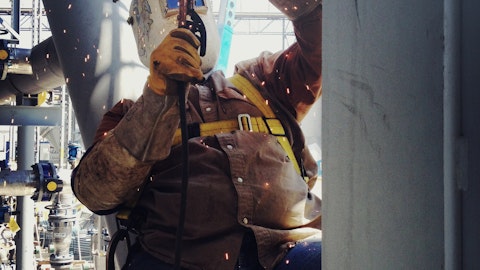And then we’re looking at our top 10 states and DoT budgets themselves that are up on average, 10%. And here’s some percentages to keep in mind. Texas, which had a really heady budget is up 24%. Florida, which has been at record levels, it’s up 9%. North Carolina, our home court is up 11%. Minnesota, when we bought the business there from Tiller several years ago, we said that was a really attractive DoT, it’s up about 38%. So, again, as we’re looking at public, we think that that’s going to be pretty compelling. Even as we sit and move to non-res, if we’re looking at manufacturing, the reshoring that we mentioned in our opening comments, is pretty significant. We continue to see more activity in that space. I also called out what we’re seeing consistently in energy.
We got a new battery plant in Kokomo, Indiana. There’s some new one coming in the Bowling Green, Kentucky. But what I’ve been a bit surprised by and I think this may be more geographic intensive as well or sensitive is even in the areas that have had degrees of slowing warehouses and data centers. I mean we’ve got four data centers under construction right now in Eastern Nebraska and Western Iowa. And there’s a new one that looks like it’s coming online in Covington, Georgia. So, again, if we look across our geographic footprint and recognize that we’ve been very selective in the where. Do I think there’s a prospect that you could see some upside in the second half of the year on volumes? Yes, I do. I think that cadence that Jim spoke to earlier, it’s important to keep in mind because clearly, we’re not going to have Q1 that last year.
But again, I think Q2, Q3, and Q4 could be attractive, recognizing, hey, pretty heady Q4. We just had this year, too. So, again, Phil, I hope that’s helpful and constructive on the volumes and what the end users look like.
Philip Ng: Appreciate the great color Ward.
Ward Nye: You bet.
Operator: Thank you. Your next question is from Tyler Brown from Raymond James. Please ask your question.
Ward Nye: Tyler, you with us?
Tyler Brown: Yes, you there? Sorry.
Ward Nye: Yes sir, we hear you. Hi Tyler.
Tyler Brown: Yes, good deal. Hey Jim, I’m curious about the CapEx guide. So, it was a little bit higher than maybe we had expected, just considering the South Texas sale. Just curious what all is in that CapEx number. Was there a sizable — was any spend in there, maybe outsized land acquisition. It just seems like 9.5% CapEx to sales feels a bit higher than normal, just particularly considering flattish volume.
Jim Nickolas: Yes, good question. Our range is between 8% to 10%, typically, 9% is the most common at the midpoint. But we do have a couple of large projects in there. And you’re right, the finished mill seven is among those that’s one of the larger spends in 2024 as we wrap up that project. Another one is our Beckman plant in San Antonio is getting a significant upgrade there as well. So, the largest items that are helping to push that up to a little bit more than normal, but still well within the range of what I think is typical for us.
Ward Nye: Hey Tyler, let me add this too because Jim nailed it. He’s exactly right. The other thing that we’re seeing, though, on occasion, and we’ve seen it more in the last few months is real estate purchases tends to be highly opportunistic. And when the right real estate shows up, you don’t always know when it’s going to parachute in and we have to have the ability to be pretty agile around that. So, we’re looking at some real estate purchases as well that that we think will be important in the near, medium and again, long-term for Martin Marietta, but broadly very much in that range that Jim spoke to, but those are some of the moving parts, both above the water and under the water.
Tyler Brown: Yes. No, that is very helpful. Thank you guys.
Operator: Thank you. Your next question is from Kathryn Thompson from Thompson Research Group. Please ask your question.
Kathryn Thompson: Hi, thanks for taking my question today. A lot of focus on all the great M&A and divestiture activity since November, certainly a busy holiday season through Super Bowl. But one of the changes also too is just in the cadence and the type of flavor of capital expenditure, CapEx as you divest some cements and take on more aggregate-focused assets. Could you walk through what this does for free cash cadence and also how we should think about capital expenditure given the change in mix? And then thoughts on capital allocation going forward, given recent activity? Thank you.
Ward Nye: So, I’m going to start with capital allocation, and then come back to Jim, and he can just talk you through more degrees of CapEx and how things can move around. If you think about the capital allocation, Katherine, one of the more elegant things about our company is that stays pretty consistent. Our view is our best first dollar spent is on the right transaction. And again, I think our teams are good at that. I think they’re good at identifying the deals. So, I think they’re good at going through the contracting process. I think they’re good at the integration process. I think they’re good at the synergy realization process. So, the right transactions will be number one on capital allocation, number two, and Jim will take you through more specifics, we’ll be reinvesting in the business.


